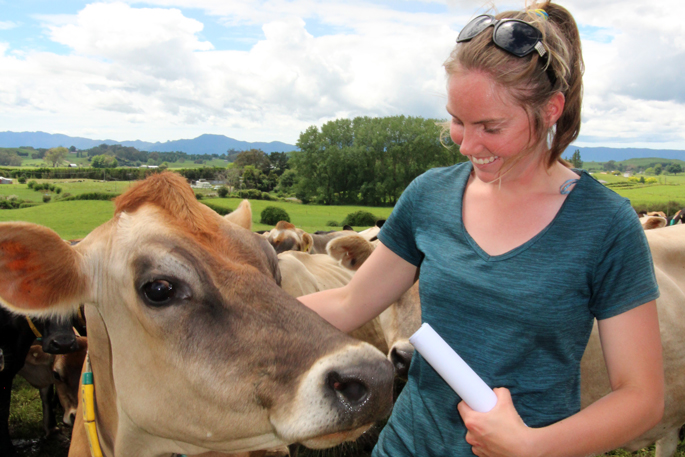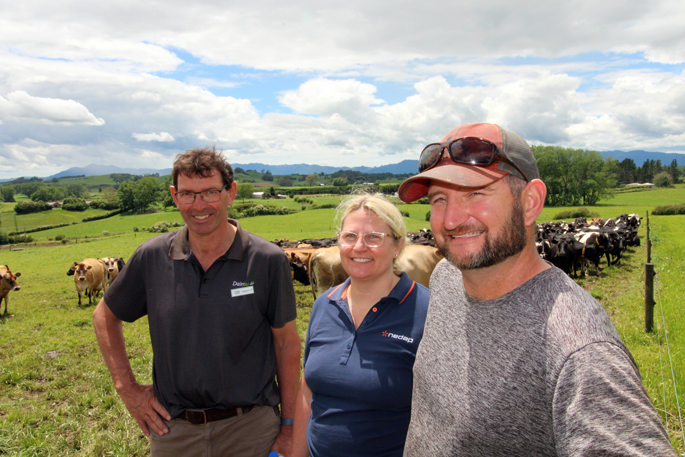A Waikato farm is being heralded as providing a test case for changing calving patterns in its dairy herd.
Chad and Jan Winke are trialling an extended lactation period – calving three times in four years – on their property near Matamata.
“It’s a new frontier,” DairyNZ extension partner Chris de Wet told the launch of the new East Waikato Jersey Group on the Winke farm at Walton.
“They are doing something that no-one else has done.”
Chad and Jan are no strangers to farm innovation and experimentation.
They originally ran just 40 cows, coupled with cropping, on a small family farm in the mid-west (Iowa) of the United States.
“It was frozen for six months of the year,” says Chad.
Jan worked for farm technology company GEA which led to a “gig” in New Zealand in 2008.
Their first stop was a dairy farm near Matamata, as “2IC” milking 600 cows.
A year later Chad and Jan made the short shift to a 1000-cow operation at Tirau, where he ultimately became farm manager.
“It was a good learning curve,” he says.
Their next move was to another Tirau farm, milking 630 cows.
Eleven seasons ago they came to Walton, as lower order sharemilkers on a 215ha property milking 650 cows.
 Herd manager Kate Langdon.
Herd manager Kate Langdon.
In their third year, Chad and Jan bought an autumn calving herd, which they ran on the same property.
They acquired the full herd five years ago and purchased a 50ha block directly across the road, milking 150 cows.
Chad says they tested different mating/calving times on the original block, which now runs 700 cows, and have “kept doing things differently” on the smaller holding.
“We want to squeeze as much out of it as we can,” he says. “Something outside the square.”
With cows performing well on the larger farm, Chad and Jan are looking to “do something similar” on the smaller block.
They believe their herd’s good milk production will continue with longer lactation.
Other potential positives include a reduction in herd health costs, less feed costs, a reduction in the number of replacement cows (bought in) required and less labour required, while milk continues to flow.
A July calving date in 2023 is followed by October in 2024, and then March in 2026 and July in 2027.
“We expect some growing pains in the transition,” says Chad and Jan.
While any financial benefits are unknown at this early stage, they say there is a degree of “satisfaction” in embarking on the venture.
Results will become apparent by calving in the autumn.
“We can get data for more than one season,” says Chad and Jan.
Chris de Wet told the jersey group launch that this is a genuine trial of extended lactation in a dairy herd.
“Studies on this have been done around the world, but just modelling. Nothing on-farm.”
“This is ground-breaking.”
Chad and Jan Winke admit they like “trying different things” in their farming practices.
The milking shed on the farm they own is an `18-a-side herringbone, but they only use 15 for “cow comfort” during milking.
A summer construction project will see the bails widened so all can be used.
The farm across the road has a 44-a-side herringbone milking shed.
Gentle handling of the animals is key, say Chad and Jan. “Talk to your cows like you would talk to a boy or a girl at the pub.”
They also stressed the importance of getting feedback from staff regarding farm operations.
“Staff form part of a team, even if they are not on the same farm,” says Chad and Jan. “Allow staff to understand what is required from them and allow the opportunity to build up skills and progress up the ladder.”
Running a mixed herd on the farm they own, with “more jerseys across the road”, they were keen to be part of the new group.
 DairyNZ extension partner Chris de Wet, left, with Jan and Chad Winke.
DairyNZ extension partner Chris de Wet, left, with Jan and Chad Winke.
Chris de Wet says Te Awamutu has the closest existing Jersey group, with the new organisation taking in Matamata, Morrinsville and the Hauraki Plains through to Waihi and Thames.
Having a separate organisation in East Waikato will reduce travel times and allow farmers to more easily access other associated groups, he says.
“The purpose is to enable Jersey cattle breeders, as well other interested farmers, to interact on a farm level with each, creating increased interest in Jersey cattle, as well as the ability to discuss any other relevant and topical farming information or systems, such as extended lactation at the Winke’s farm.
The next meeting is planned for February, but specifics including date, host farmers and topics still need to be confirmed.
Information can be found on the DairyNZ website closer to the time.



0 comments
Leave a Comment
You must be logged in to make a comment.